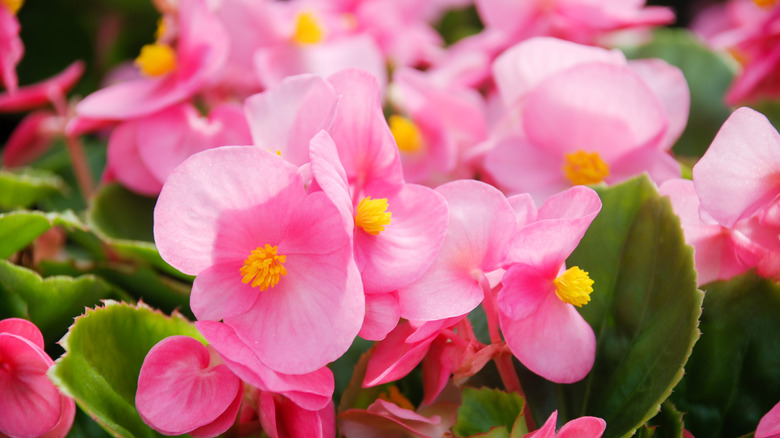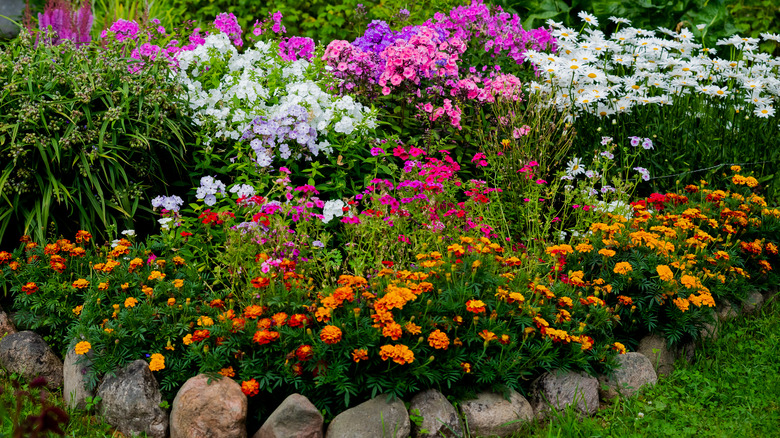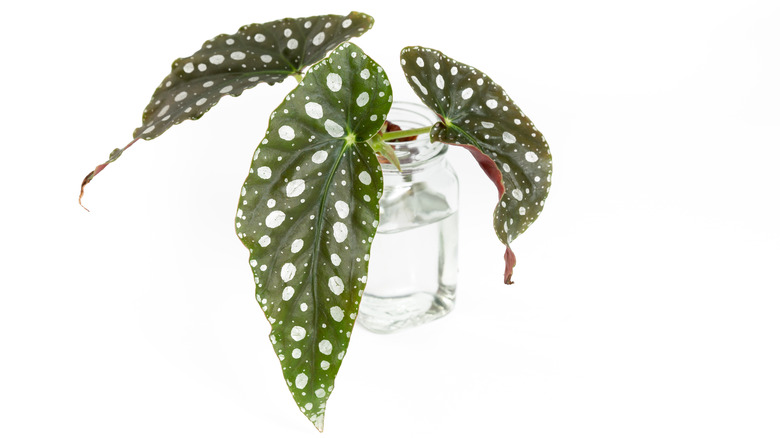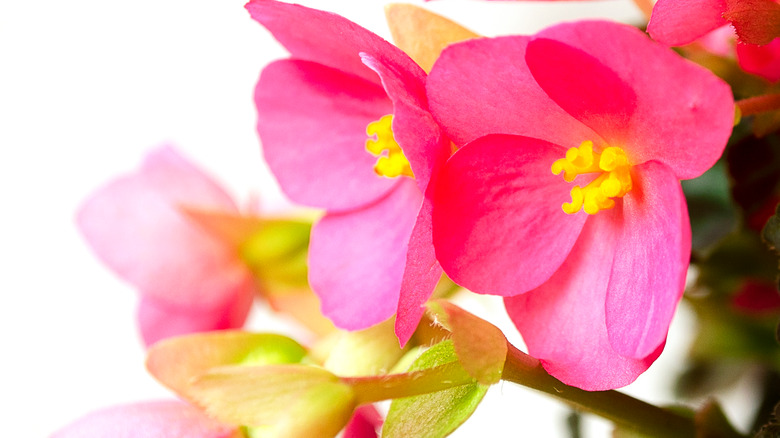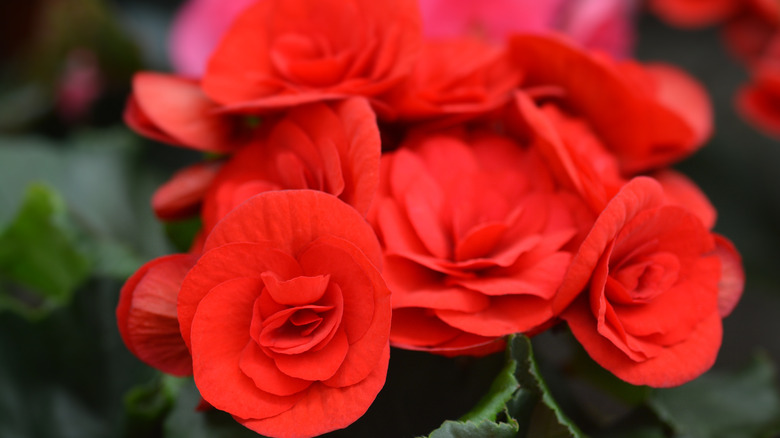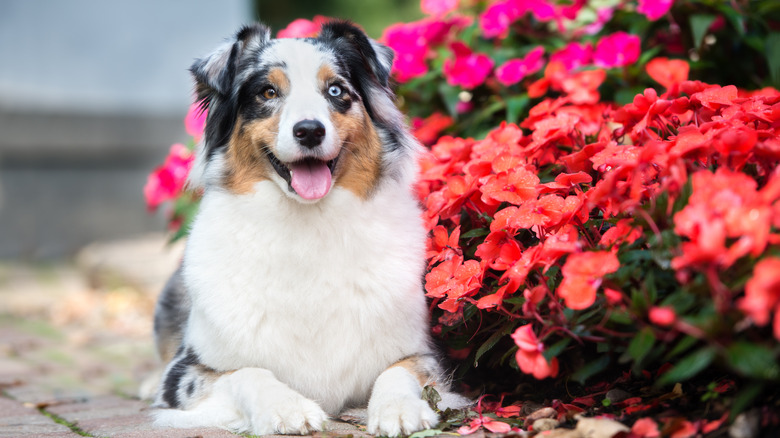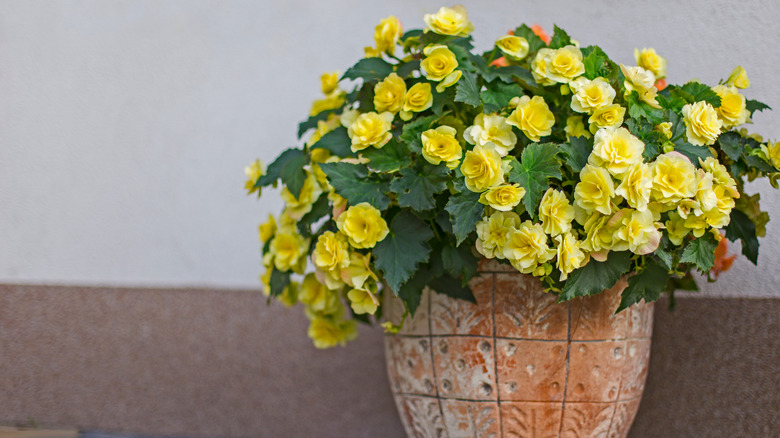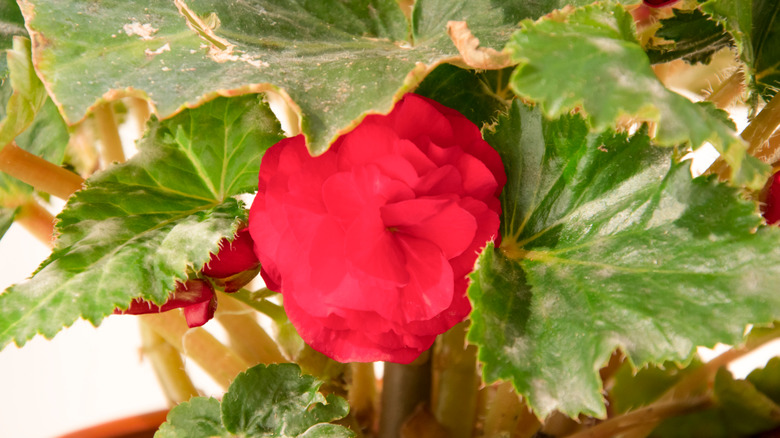How To Grow And Take Care Of Begonias
With close to 2,000 species within the begonia genus (family Begoniaceae) and 10,000 hybrid species, there are plenty of stunning options to make your garden designs unique. While begonias are capable of being perennial in more tropical regions such as South Florida, most are simply grown as annuals because the maximum lifespan of a begonia tends to be two to three years. The flowers of these vibrant plants range from yellow to white to red. In fact, the only color you won't find them in is blue, as per The American Begonia Society. Whether the flowers are displayed as single stems or clusters of blooms depends largely on the species. Leaves also differ in size (from 2.5 cm to 30 cm) and texture. Begonias can even be evergreen or deciduous, meaning some varieties don't lose their leaves in cold weather while others lose their leaves annually. Plants range from 6 to 12 inches, and the shrub varieties can grow up to 5 feet tall.
According to BloomIQ, the begonia was discovered in Brazil by a Franciscan monk, Charles Plumier, who was an amateur botanist on the hunt for medicinal plants. While the discovery occurred in 1690, there wasn't much international interest until samples were mistakenly sent to the Berlin Botanical Garden in 1821.
Begonias love humidity and are perfect for terrariums but are hardy enough to thrive just about anywhere. Their adaptability and wide variety make begonias popular choices for planters, garden beds, and hanging baskets.
How to use begonias in garden
Thanks to their range of bright flowers and interesting leaves, begonias make a fantastic addition to your garden. Especially when paired with neighboring plants of complementary colors, like Impatiens and Coleus, begonias are perfect for adding a splash of color to your garden beds or containers. Plant them under large trees, shrubs, or ferns, as noted by Garden Design. Take advantage of their bold colors in your garden beds and hanging baskets, and you'll have hummingbirds thanking you all summer.
Companion plants help retain humidity in your garden, which is ideal for your humidity-loving begonias. When considering companion plants, also keep in mind that the needs of the paired plants must match the needs of the begonia, as per SFGate. Make sure all companion plants can tolerate moist conditions and shade.
As a reminder, begonias are tropical plants. If you plant begonias outside of zones 9 or 10, they is unlikely to survive winter. It is common to treat begonias as annual plants instead, but you can also plant them in containers and bring them inside over the winter.
How to grow begonias
It's easier and faster to grow begonias from propagations. Growing from seeds takes significantly longer. In fact, some hybrid seeds are even developed to be sterile and unviable. Start seeds indoors eight to 12 weeks before the last frost in your region. Keep the seedlings in a location with plenty of indirect sunlight. Soil should be kept moist but avoid letting begonias sit in water. Cover your seedling containers with clear plastic bags or saran wrap to increase humidity, as per American Meadows. This helps the soil retain moisture evenly and avoids potential stem or root rot.
All varieties of begonias are easily propagated in water or soil with stem cuttings. To propagate in water, cut a begonia stem just below a node, leaving the cutting with about 1 inch of stem and place in a glass or mason jar. Keep water levels just above the node to avoid stem rot. To propagate in soil, place the cutting in a tray of evenly moist, well-draining soil just deep enough to cover the petiole. Keep the soil evenly moist and place in indirect sunlight, such as an east-facing window. Cuttings will be rooted and ready to plant within six to eight weeks when the roots are at least 1/2-inch long. You can use rooting hormone for faster results, but begonias don't need it to propagate well. It will be safe to plant your begonias outside once nighttime temperatures are consistently above 45°F.
How to care for begonias
Begonias are hardy, so even if conditions aren't ideal, caring for them is simple if the soil, sunlight, and watering conditions are met. Begonias prefer light, well-draining soil that can keep their root ball moist without sitting in excess water. According to Martha Up Close and Personal, you can mix soil with extra perlite to increase the drainage. Avoid planting begonias in areas that receive extended amounts of direct sunlight, as the leaves are susceptible to scorching. Begonias prefer bright, indirect light and at least partial shade. Place containers near shady porches or plant in-ground under large trees or shrubs, suggests Garden Design.
Wait until the soil is relatively dry between watering to decrease the risk of root rot. Watering at the base of the plant is also safer for the begonia because standing water on the leaves and blooms can lead to health problems such as mildew, diseases, and pests, explains HGTV.
Many begonia varieties are bred specifically to maximize the number of blooms. For continuous growth and healthier blooms throughout the growing season, apply a fertilizer with a balanced amount of nitrogen, phosphorous, and potassium halfway through the growing season.
Begonia varieties
There are close to 2,000 varieties of begonias, all native to tropical and subtropical regions of South America, Asia, and sub-Saharan Africa. Most begonias are classified by three main categories based on root structure, according to Bob Vila. Depending on the root structure, begonias can grow from 6 inches to 3 feet tall. Flowers can range from red, orange, pink, white, or yellow. Foliage can be found in blue-green hues as well as burgundy.
Tuberous begonias (begonia x tuberhybrida) are grown from potato-like tubers and are shrub-like. One of the most popular species is a hybrid known as Dragon Wing Pink, also called Angelwing Begonia. It is highly desired for its lush, mounded style, bright pink blooms, and resistance to deer and rabbits.
Rhizomatous Begonias are loved for their colorful foliage and don't produce nearly as many blooms as the tuberous varieties. Rex Begonias (Begonia rex), also known as "painted-leaf" or "king" begonias due to the striking colors and textures of its arrowhead-shaped leaves, can combine lush ranges of yellow, green, purple, and red. Rex Begonias are native to the forested regions of India, China, and Vietnam, as noted by Houseplant Central.
Fibrous begonias, such as the popular wax begonias (Begonia x semperflorens-cultorum), are perfect for window boxes and hanging baskets, as per The Spruce. Popular cultivars of wax begonias include Paint Splash Pink, which has pale pink blooms and equally unique foliage of green with cream spots.
Are begonias toxic?
All species of begonias are toxic to both humans and animals and should not be ingested. The needle-like crystals in begonia sap are the same calcium oxalate crystals responsible for the formation of kidney stones in humans. When consumed, they embed themselves and shred cell walls like tiny shards of fiberglass.
Consumption of the plant is mildly toxic in humans and may cause burning and vomiting, but it can cause vomiting and kidney failure in animals, according to the ASPCA. Begonias are toxic to cats and dogs, but cases of poisoning can be very severe for horses due to the higher amount of plant material they are capable of consuming. The most toxic part of the plant are the stems and roots. Tuberous roots are considered especially poisonous and should not be ingested.
Handling begonias is perfectly harmless, but you should wash your hands after handling or pruning so you don't accidentally transfer sap to your food or face, as per The Spruce.
How to repot begonias
Wax begonias enjoy containers and prefer to be a bit root bound, so they won't require repotting very often. In fact, if planted in a pot that is too large, the roots will rot due to the excess soil, nutrients, and water. Wait to repot wax begonias until the container is filled with roots, shares Gardening Know How. You can tell the begonia still has room to grow if there is still loose soil in the pot.
You can repot anytime throughout the year, but springtime is best when the begonia is beginning its growing season. When choosing a new pot, make sure you have 1 inch of space between the tubers or root ball and the edge of the pot. Because tera cotta pots absorb water and draw moisture away from the plant, it's best to choose a plastic pot for begonias.
According to Martha Up Close and Personal, use a potting medium that is equal parts perlite, peat moss, and vermiculite. Add a bit of water so the potting medium is lightly moist. Gently remove the begonia from its original pot and shake off the loose, old soil. Add a thin layer of new potting mix in the bottom of the pot, then insert the begonia and firmly pack the new potting mix around the plant. According to the American Begonia Society, firmly packing the soil into the new pot eliminates air pockets that can trap water and lead to root damage.
Begonia pests and diseases
Begonias are at risk of root rot and mildew caused by overwatering. To avoid this, water plants at the base to avoid excess water on buildup on the leaves and plant companion plants at least 1 foot away to increase air circulation. You can also spray infected plants with a fungicide if necessary. Clean your gardening tools and wash your hands to avoid spreading fungal infections to healthy plants. To mitigate spread, remove dead or dying leaves and flowers and apply fungicide to protect plants. If plants are severely infected, it may be best to discard them to ensure viruses don't spread to the rest of your garden.
Begonias are also vulnerable to mealybugs, slugs, spider mites, and thrips, explains the American Begonia Society. Mites are difficult to see, but you will find evidence of them by yellow spotted leaves and discolored or brittle young leaves. Miticides and other pesticides are helpful in these cases, but neem oil is another popular organic, non-toxic option. To eradicate mealybugs, spray the area with soapy water. This method is effective but may take several treatments depending on the severity of the infestation.
